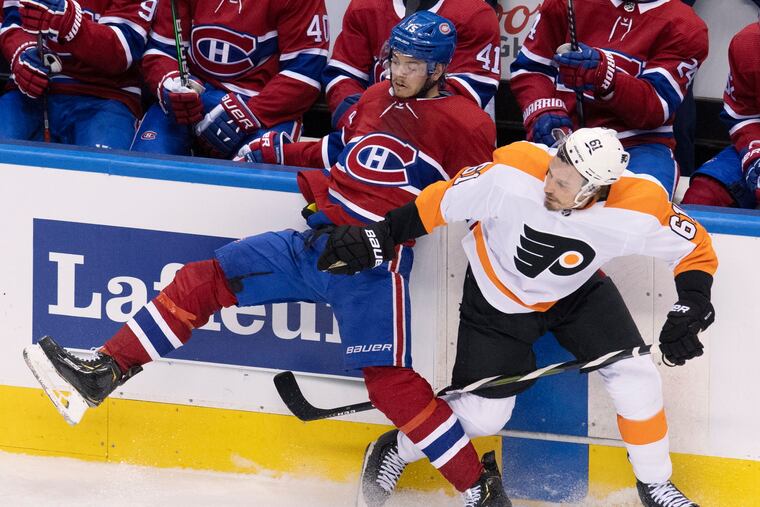Goals be damned, the Flyers are winning by playing with toughness and guts | Mike Sielski
They're suffocating the Canadiens, playing a style that is tough to watch but is awfully effective.

On the short list of Most Dangerous Things to Happen to an NHL Player, trying to block a Shea Weber slap shot has to rank somewhere near the top. Weber is generally acknowledged, by reputation and by radar gun, to have the hardest shot in the National Hockey League. He won the competition at this year’s All-Star weekend by unleashing one that reached 106.5 mph. In 2015, he topped 108 mph. People use the term weapon often in sports. It’s usually a metaphor. When it comes to Weber’s shot, it’s a fact.
Roughly 90 seconds into the third period of the Flyers’ 2-0 victory Tuesday in Game 4 of their playoff series against the Canadiens, Weber wound up for a one-timer from just above the left circle. Flyers defenseman Robert Hagg didn’t think. He just went down. It’s just the thing you’re supposed to do during the NHL postseason. If you can keep your goaltender from having to make a difficult save, from making any save, down you go — excruciating pain and broken bones be damned.
“It takes a lot of balls to do that,” said Flyers defenseman Phil Myers, who scored the team’s second goal Tuesday. “He loves paying the price for the boys.”
When he hit the ice a few feet in front of Weber, Hagg was fortunate that he didn’t pay the price with his boys. The puck instead struck him in the back of his helmet and caromed away. Hagg remained down for a bit before getting back to his skates. In the context of the NHL playoffs, it was an ordinary play. It was the sort of play expected from a player on a team that hopes or expects to win a Stanley Cup. In the context of Game 4, it was the best example of the excellence of the Flyers’ defensive play.
» READ MORE: Carter Hart blanks Montreal again as Flyers take 3-1 series lead
Carter Hart has been perfect over these last two games, but the degree of difficulty of these shutouts wasn’t on par with his performance in Game 1, when he actually gave up a goal. These last 120 minutes have been the hockey equivalent of an Animal Planet episode, with the Flyers as the python and the Canadiens as the poor little antelope. It’s not the most comfortable or pleasing event to watch, but the outcome is inevitable.
“We’re not playing perfect hockey, without a doubt,” Flyers coach Alain Vigneault said. “When we do make mistakes, [Hart has] been able to get that big save for us. In front of him, also there’s a lot of effort going on there, both to be in the right position and obviously to block shots. There were a couple very desperate plays on our part from guys [who] got in the way, and that’s a big part of finding ways to win. Those defensive plays are as important as the offensive part.”
More important, so far. Over their seven games since the start of the round robin, the Flyers have given up nine goals. That’s an average of 1.29 a game. That’s the best in the NHL. They’ve scored five goals in their four games against Montreal and have somehow won three of them. Thanks to that abysmal 5-0 loss in Game 2, they’re actually being outscored in this series, 6-5. They’re thriving by playing a style that has worked against them in the past. If you have any long-term memory of the franchise’s postseason history, you’re watching this series and wondering whether Vigneault downloaded the 1995 New Jersey Devils’ neutral-zone trap from Jacques Lemaire’s brain.
Yes, Hart is getting the headlines and the national praise for outplaying his idol, Carey Price. But the series has also been a testament to the Flyers’ talent and depth on defense, to the measures that general manager Chuck Fletcher and his predecessor, Ron Hextall, took to improve the unit. Hextall made sure Hagg, Myers, Ivan Provorov, and Travis Sanheim were already here. Fletcher added Matt Niskanen and Justin Braun. The ease and smoothness with which the Flyers are able to advance the puck out of their defensive zone is a subtle yet vital aspect to their success. So is their forwards’ ability to win faceoffs (65% in Game 4) and willingness to back-check. So, on Tuesday, was their willingness to block shots — 13 in all.
» READ MORE: Observations from the Flyers’ 2-0 win over Canadiens in Game 4
“You have to play that 200-foot game,” Vigneault said. “You have to be committed. Our players are right now.”
One could argue that a player ought to be committed for doing what Hagg did. But it was still just a two-goal game then, and if Hagg doesn’t try to block Weber’s shot and the puck zooms past Hart and into the net, who knows what happens? In the playoffs, you don’t ask such questions. The Flyers, to their credit, aren’t.